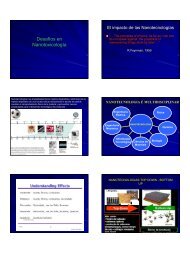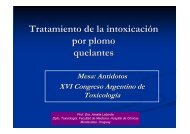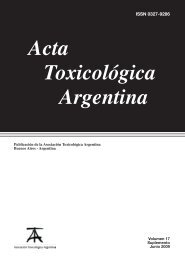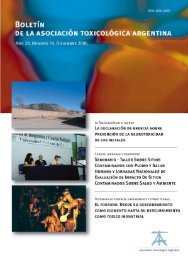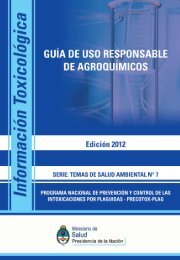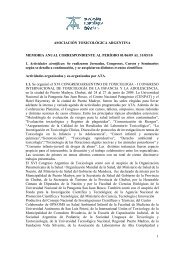Argentina
Acta Toxicológica Argentina - ATA
Acta Toxicológica Argentina - ATA
Create successful ePaper yourself
Turn your PDF publications into a flip-book with our unique Google optimized e-Paper software.
Acta Toxicol. Argent. (2007) 15 (1): 29-33<br />
• Las tablas y sus leyendas se presentarán en<br />
forma individual, en hoja aparte, identificadas<br />
mediante numeración arábiga conforme al orden<br />
en que aparecen en el texto.<br />
La ubicación preferente de la tabla en el texto se<br />
indicará mediante<br />
una flecha. Las tablas se ubicarán al final de cada<br />
manuscrito.<br />
• Las citas bibliográficas en el texto se indicarán<br />
mediante números correlativos, por orden de aparición,<br />
entre paréntesis; por ejemplo: "la separación<br />
de las isoenzimas se hizo por electroforesis<br />
de acuerdo a la técnica de Dietz y Lubtano (4)"<br />
En el caso de citar artículos de más de dos autores,<br />
se indicará el apellido del primero seguido de<br />
la expresión et al.: "Castañé et al. (5) fueron los<br />
primeros en..."<br />
Las referencias bibliográficas serán agrupadas<br />
bajo el acápite "Bibliografía citada"; la lista se ordenará<br />
conforme a los números asignados.<br />
El formato de las citas es el siguiente:<br />
Artículo en publicación periódica:<br />
"Malla Reddy, P. and Bashamohideen M. (1989).<br />
Fenvalerate and cypemmerhrin induced changes<br />
in the haematological parameters of Cyprinus carpio.<br />
Acta Hidrochim. Hidrobio. 17 (1), 101-107"<br />
Libro: " Dix, H.M. (1981), Environmental pollution.<br />
John Wiley & Sons, New York, 286 pp."<br />
Las abreviaturas de la denominación de la revista<br />
serán las que ellas mismas indican en su texto.<br />
• Cualquier modificación excepcional de las normas<br />
estipuladas que los autores soliciten será considerada<br />
por el Director.<br />
• Las pruebas de galera se enviarán al autor indicado<br />
como receptor de la correspondencia. Las<br />
mismas serán revisadas y devueltas dentro de las<br />
48 horas de recibidas.<br />
• El autor indicado recibirá 10 separatas sin cargo.<br />
El excedente solicitado sobre esa cantidad será<br />
costeado por el/los autores: la cantidad solicitada<br />
deberá ser indicada al Editor en el momento de<br />
devolver las pruebas de galera.<br />
Toda la correspondencia referida a "Acta Toxicológica<br />
<strong>Argentina</strong>" deberá ser dirigida al Comité<br />
Editorial, Alsina 1441 (1088) Buenos Aires,<br />
<strong>Argentina</strong> Telefax ++54-11-4381-6919.<br />
Se solicita canje con otras publicaciones temáticamente<br />
afines a Acta Toxicológica <strong>Argentina</strong>.<br />
INSTRUCTIONS TO CONTRIBUTORS<br />
Acta Toxicológica <strong>Argentina</strong> (Acta Toxicol. Argent.)<br />
(ISSN 03279286) is the official journal of the<br />
Asociación Toxicológica <strong>Argentina</strong> (Argentine<br />
Toxicological Association) for scientific diffusion.<br />
Acta Toxicológica <strong>Argentina</strong> (herein below "Acta")<br />
is basically aimed at publishing original full-length<br />
papers, short communications, reports on research<br />
in progress or review papers, topics of interest to<br />
workers in Toxicology, book reviews, technical communications<br />
as well as letters to the Editor. News<br />
relevant to the different fields of Toxicology will<br />
also be published.<br />
ATA will publish articles written in either Spanish,<br />
Portuguese or English. Every article will be evaluated<br />
by two examiners. Only the Editorial Board will<br />
be responsible for selecting articles with –that is,<br />
decisions about (a) rejected articles, (b)accepted<br />
articles with, however, changes to be introduced by<br />
authors, or (c) accepted articles with no changes<br />
whatsoever are a privilege of the Editor Board. In<br />
all cases, authors will receive an unsigned copy of<br />
the examiners’ evaluation. Scientific original manuscripts<br />
submitted to the consideration of the<br />
Editorial Board should adhere to the following basic<br />
format:<br />
• Page 1: Title, and subtitle of paper. Author’s full<br />
names; academic or professional affiliation, and<br />
complete name of the laboratory or institution<br />
where research was done.<br />
Complete address (city, State or Province, zip code,<br />
country, e-mail, phone number and fax number).<br />
• Page 2: Title of paper in Spanish and English. A<br />
list of three or four key words in Spanish or<br />
Portuguese and English should be included.<br />
• Page 3 onward: As a rule, full length papers<br />
should be divided into sections headed by a caption:<br />
Introduction, Materials and Methods, Results,<br />
Discussion, Acknowledgements, References, caption<br />
of figures and caption of tables.<br />
Full-length papers should not exceed eight pages.<br />
Text should be typed with PC, on A4 paper, in double-spaced<br />
typing with at least 4 cm upper lower,<br />
and left margin. Typescripts should be submitted in<br />
triplicate. Besides the 3 copies of the manuscript,<br />
authors are requested to submit the paper on<br />
diskette (3 1/2") made in one of the next word processing<br />
systems: Word for MS-DOS; Word for<br />
MACINTOSH; Word Perfect for DOS indicating the<br />
program and version used. Revised versions of the<br />
paper, because of referee’s recommendations<br />
should always be accompanied by a new diskette<br />
and 3 printouts of the manuscript.<br />
Short communications should adhere to a similar<br />
format. However it should contain no section headings,<br />
but text is supposed to contain, in a concise<br />
way, every information relevant to the above mentioned<br />
headings (Introduction, Materials and<br />
Methods, etc.). Short communications should not<br />
exceed three pages.<br />
Review papers, updating, and reports on research<br />
in progress should be as concise as can be. Such<br />
articles should not exceed three pages. Their wording<br />
should address a scientifically educated reader-ship<br />
that, however, can be unfamiliar with topics<br />
involved. Review papers, updating, and reports on<br />
research in progress previously requested to<br />
- 30 -




